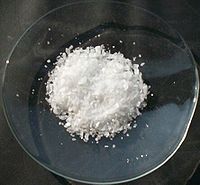
Photo from wikipedia
Abstract Deflagration to Detonation Transition (DDT) is an intricate problem that has been tackled numerically, until recently, using single-step chemical schemes. These studies (summarized in Oran and Gamezo, 2007) [1]… Click to show full abstract
Abstract Deflagration to Detonation Transition (DDT) is an intricate problem that has been tackled numerically, until recently, using single-step chemical schemes. These studies (summarized in Oran and Gamezo, 2007) [1] showed that DDT is triggered when a gradient of reactivity forms inside a pocket of unreacted material. However, recent numerical simulations of hydrogen/air explosions using detailed reaction mechanisms (Liberman et al., 2010; Ivanov et al., 2011) [2] , [3] showed that detonation waves can emerge from the flame brush, unlike what was usually seen in the single-step simulations. The present work focuses on chemistry modeling and its impact on DDT. Using the idealized Hot Spot (HS) problem with constant temperature gradient, this study shows that, in the case of hydrogen/air mixtures, the multi-step chemical description is far more restrictive than the single-step model when it comes to the necessary conditions for a hot spot to lead to detonation. A gas explosion scenario in a confined and obstructed channel filled with an hydrogen/air mixture is then considered. In accordance with the HS analysis, the Zeldovich’s (1970) mechanism [4] is responsible for the detonation initiation in the single-step case, whereas another process, directly involving the deflagration front, initiated DDT in the complex chemistry case. In the latter, a shock focusing event leads to DDT in the flame brush through Pressure Pulse (PP) amplification.
Journal Title: Combustion and Flame
Year Published: 2019
Link to full text (if available)
Share on Social Media: Sign Up to like & get
recommendations!